Introduction to What’s the difference between crème brûlée and custard?
Crème brûlée and custard are two beloved desserts that have captured the hearts of dessert enthusiasts worldwide. On the surface, they seem similar, sharing creamy textures and essential ingredients like eggs, cream, and sugar. However, if you’ve ever wondered, “What’s the difference between crème brûlée and custard?”, you’re not alone!
In this guide, we’ll uncover the distinct qualities of these classic desserts, diving into their origins, textures, preparation methods, and even their unique flavor profiles. Whether you’re a foodie, a home baker, or someone just curious about these sweet treats, you’re in for a delicious journey. Let’s explore the subtle yet significant distinctions that set crème brûlée and custard apart.
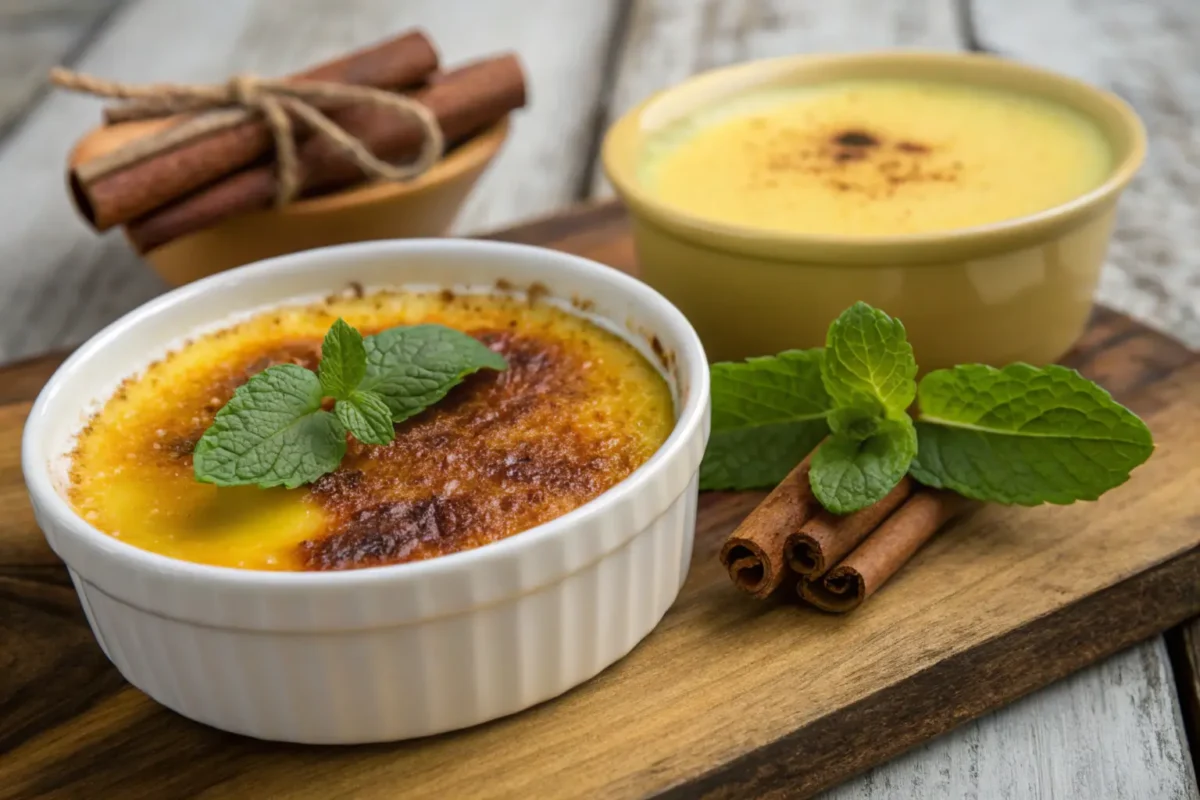
What Is Crème Brûlée?
Origins and Popularity
Crème brûlée traces its roots back to France, where it gained fame as a luxurious dessert enjoyed in fine dining. The name translates to “burnt cream,” referring to the caramelized sugar topping that defines its presentation. While its exact origins are debated, some believe its history spans back to similar desserts in England (burnt cream) and Spain (crema catalana).
Today, crème brûlée stands out as a dessert synonymous with elegance, often reserved for special occasions or fancy restaurant menus. Its global popularity has also given rise to unique variations, incorporating flavors like matcha, lavender, and even chocolate.
Defining Features
The standout feature of crème brûlée is its caramelized sugar crust. This thin, glass-like layer is achieved by sprinkling sugar over the creamy custard base and using a blowtorch (or broiler) to melt and harden it.
Beneath the golden shell lies a rich, silky custard infused with subtle vanilla notes. The satisfying contrast between the crunchy top and the smooth interior is what makes crème brûlée so irresistible.
Crème brûlée is typically served in shallow, wide ramekins, which allow for a larger surface area to caramelize. This visual and textural element is part of what makes it distinct from other custard-based desserts.
By understanding these features, you can start to appreciate the finer points of crème brûlée and what sets it apart in the dessert world. Up next, we’ll dive into the equally versatile and popular custard.
What Is Custard?
Versatility of Custard
Custard is one of the most adaptable desserts in the culinary world. Its creamy texture and mild flavor make it a perfect base for various dishes, both sweet and savory. So, what’s the difference between crème brûlée and custard? While crème brûlée is a specific type of custard, custard itself comes in many forms.
Custard is made by combining eggs, cream or milk, and sugar, then cooking it gently to achieve its smooth consistency. It can serve as the star of a dessert, like flan, or act as a component in pastries, such as éclairs and cream puffs. This versatility has cemented custard’s role in countless cuisines worldwide.
Types of Custard
Custards come in three main types, each with its own preparation method:
- Baked Custard: This is perhaps the closest relative to crème brûlée. Baked custard is prepared in a water bath, creating a smooth, set texture. Examples include flan and crème caramel.
- Stirred Custard: This type, like crème anglaise, is cooked on the stovetop and stirred continuously. It’s used as a sauce for desserts or as a base for ice cream.
- Steamed Custard: Popular in Asian cuisines, this type is lighter and cooked over steam. It can be sweet or savory, depending on the recipe.
Unlike crème brûlée, custard doesn’t always include a caramelized topping, which is one of the most notable differences between the two.
Key Differences Between Crème Brûlée and Custard
Preparation Techniques
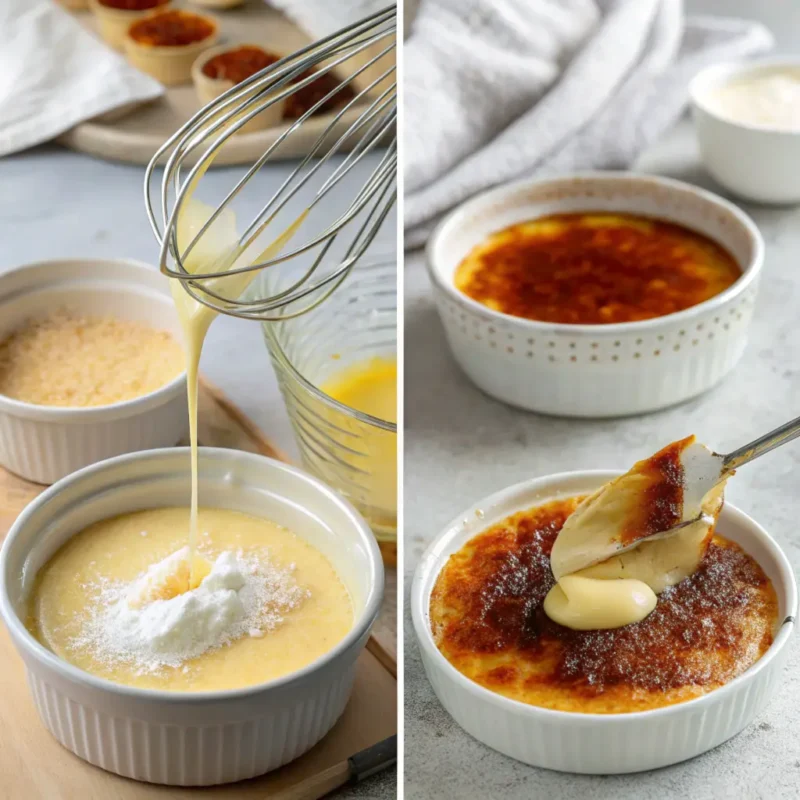
One of the main distinctions lies in how these desserts are prepared. Crème brûlée involves an additional step: caramelizing the sugar topping. A blowtorch is often used to achieve this signature crunchy layer, but a broiler can work in a pinch. Custard, on the other hand, doesn’t require this step and is usually served as-is or with a sauce, like caramel or fruit coulis.
The cooking methods also vary. While both desserts can be baked in a water bath, custard can also be steamed or cooked on the stovetop, giving it more flexibility in preparation. This versatility highlights what’s the difference between crème brûlée and custard in terms of technique.
Toppings and Presentation
Another noticeable difference is how these desserts are presented. Crème brûlée is famous for its caramelized sugar crust, which adds both flavor and texture. The topping cracks beautifully under a spoon, creating an interactive element that custard lacks.
Custard, in contrast, is often served plain or with additional toppings like fresh fruit, nuts, or whipped cream. The absence of a caramelized layer gives it a softer, more uniform texture, which some people prefer for its simplicity.
By understanding these key differences, you can appreciate how crème brûlée and custard offer distinct culinary experiences, despite sharing similar ingredients. Next, we’ll explore the similarities that connect these two creamy delights.
Similarities Between Crème Brûlée and Custard
Shared Ingredients
One of the most notable similarities between crème brûlée and custard is their shared ingredients. Both desserts are built on a base of eggs, cream (or milk), and sugar, which combine to create their rich and creamy textures. These simple ingredients make both desserts versatile and easy to customize with flavors like vanilla, chocolate, or citrus.
While their preparation methods differ, this shared foundation connects the two desserts, highlighting their mutual French culinary roots. If you’ve ever asked, “What’s the difference between crème brûlée and custard?”, you now know that the ingredients themselves aren’t what set them apart—it’s how they’re used.
Culinary Flexibility
Crème brûlée and custard also share a remarkable level of flexibility in the kitchen. Both desserts can take on new flavors effortlessly, from the addition of vanilla beans to infusions of lavender or espresso.
Additionally, both desserts can serve as a base for more elaborate creations. Crème brûlée’s custard base can be repurposed for filled pastries, while custard can be turned into ice cream or used in layered desserts like trifles. This versatility ensures that both desserts remain staples in both professional and home kitchens.
Common Challenges and Mistakes
Overcooking or Undercooking
One of the key challenges when making either crème brûlée or custard is getting the cooking time just right. Overcooking either dessert can result in a rubbery, grainy texture, while undercooking leaves it runny and unset.
To avoid these issues, always use a water bath for baked versions of both desserts. The water bath provides gentle, even heat, ensuring the custard sets perfectly without curdling. If you’re making crème brûlée, the trick is to remove the ramekins from the oven when the centers are still slightly jiggly—they’ll firm up as they cool.
Sugar Caramelization Troubles
When caramelizing the sugar topping for crème brûlée, it’s easy to burn the sugar or create uneven results. To achieve the perfect crunchy layer, use a blowtorch and keep the flame moving. If using a broiler, watch closely to avoid overcooking.
For custard, which doesn’t typically feature a caramelized topping, the challenge lies in avoiding skin formation during baking. Covering the ramekins with foil can help prevent this issue.
For more dessert tips, check out Makouri Recipes’ guide to The Secret to Crème Brûlée for detailed techniques and tricks to perfect your custard-based creations.
How to Decide Between Crème Brûlée and Custard
Choosing Based on Occasion
When deciding which dessert to make, it often comes down to the occasion. Crème brûlée is perfect for formal dinners or celebrations where you want to impress your guests. The caramelized sugar topping adds a touch of elegance and an element of surprise when served. If you’re aiming to make a statement, crème brûlée is your go-to.
Custard, on the other hand, is ideal for more casual settings. Its simplicity makes it a comforting treat that works well for everyday indulgences or as part of larger desserts, like trifles or pies. If you’re in the mood for something quick and versatile, custard fits the bill.
Time and Tools Needed
Another factor to consider is the time and equipment required. Crème brûlée involves an extra step—caramelizing the sugar—which requires a blowtorch or careful use of a broiler. This step adds complexity but also elevates the final presentation.
Custard, in contrast, is simpler and quicker to prepare. Whether you’re making it stovetop or baked, it doesn’t require specialized tools, making it more accessible for beginners. If you’re wondering, “What’s the difference between crème brûlée and custard?”, the preparation process is a significant distinction to keep in mind.
Pairing and Presentation of Crème Brûlée and Custard
Perfect Pairings
When considering what’s the difference between crème brûlée and custard, pairing each dessert with the right accompaniments can enhance its unique qualities. Crème brûlée, with its rich and decadent profile, pairs beautifully with fresh berries like raspberries or blueberries. Their natural tartness cuts through the creamy custard and complements the caramelized sugar topping.
Custard, being more versatile, works well with a variety of pairings. Serve it alongside a slice of pie, layer it into a trifle, or top it with a sprinkle of cinnamon for a cozy, simple treat. The lighter flavor of custard makes it ideal for pairing with stronger elements like chocolate, caramel, or citrus.
Elegant Presentation
The presentation styles of crème brûlée and custard differ significantly and reflect their unique characters. Crème brûlée is typically served in shallow ramekins to emphasize its caramelized sugar crust. Garnishing with a mint sprig or edible flowers can elevate the look even further.
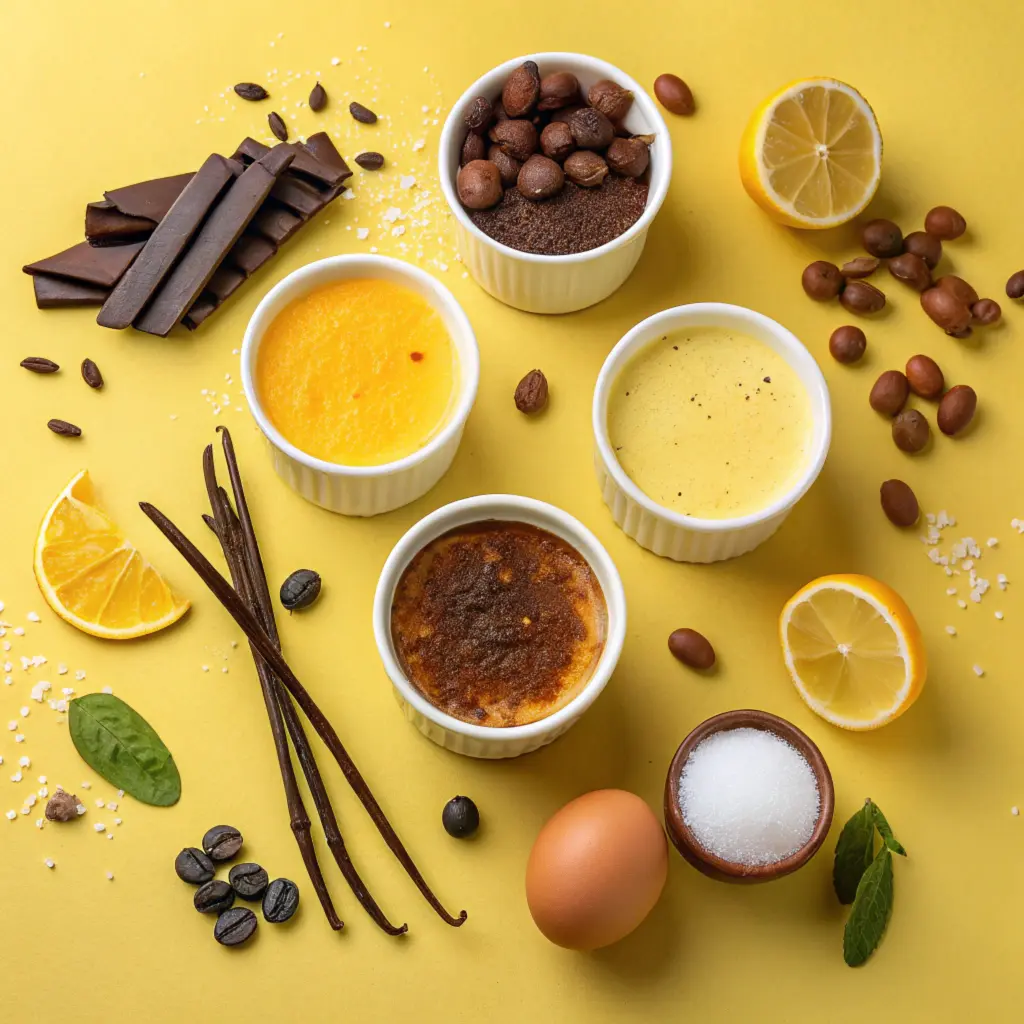
Custard, on the other hand, can be presented in various ways. It may be poured into bowls, baked in deep dishes, or layered in a dessert glass. Adding whipped cream, a drizzle of fruit coulis, or a handful of nuts can enhance its visual appeal and flavor.
Why You Should Try Both
Appreciating Their Differences
While crème brûlée and custard share a common base, their differences make them special in their own ways. Crème brûlée’s standout feature is its caramelized sugar crust, which adds a satisfying crunch and visual drama. Custard, with its simpler preparation and adaptability, shines as a versatile dessert for both casual and elaborate occasions.
When deciding which to make, think about the setting and the tools you have on hand. If you’re hosting a dinner party and want to impress, crème brûlée is a showstopper. For everyday enjoyment or a base for other desserts, custard is your go-to.
Why Both Desserts Are Timeless
Ultimately, both desserts have stood the test of time for good reason. They highlight the beauty of simple ingredients like eggs, sugar, and cream, transformed into something magical. Whether you’re cracking into a crème brûlée or savoring the smoothness of custard, both desserts offer a satisfying and indulgent experience.
So, now that you know what’s the difference between crème brûlée and custard, why not try both and see which one becomes your favorite? Whichever you choose, you’re sure to enjoy the creamy, sweet satisfaction that only these desserts can deliver.
Frequently Asked Questions
Does Crème Brûlée Taste Like Custard?
Crème brûlée does taste similar to custard because both share a creamy, rich base made from eggs, sugar, and cream or milk. However, crème brûlée stands out with its caramelized sugar topping, which adds a smoky sweetness and a delightful crunch. While custard is smooth and consistent throughout, crème brûlée provides a contrast between the silky custard and its crisp top.
What Is the Difference Between Baked Custard and Crème Brûlée?
The main difference lies in the finishing touch. Baked custard is a simple, smooth dessert with no additional topping, often flavored with vanilla or nutmeg. Crème brûlée, on the other hand, features a caramelized sugar crust that adds both texture and flavor. Additionally, crème brûlée is typically served in shallow ramekins to maximize the caramelized surface area, while baked custard can be made in deeper dishes.
Is Crème Brûlée Served Warm or Cold?
Crème brûlée is traditionally served cold with a freshly caramelized sugar topping that’s warm. The contrast between the cool custard and the warm, crackly sugar layer is one of the dessert’s most appealing features. To achieve this, the custard is chilled thoroughly before the sugar is caramelized just before serving.
What’s the Easiest Dessert to Make?
If simplicity is your priority, custard is easier to make than crème brûlée. Custard requires fewer steps and no special equipment, making it more beginner-friendly. Crème brûlée, while not overly complex, demands extra attention during the sugar caramelization stage.
Can You Use Custard as a Base for Crème Brûlée?
Absolutely! Crème brûlée is essentially a baked custard with a caramelized topping. You can use a standard baked custard recipe as the base, then add sugar and caramelize it with a blowtorch or broiler to transform it into crème brûlée.
By answering these common questions, we hope to clarify what’s the difference between crème brûlée and custard? and help you choose the perfect dessert for any occasion.
Conclusion: Celebrating the Best of Crème Brûlée and Custard
Crème brûlée and custard are two classic desserts that showcase the magic of simple ingredients. While they share a creamy base made from eggs, sugar, and cream, their differences make them equally special. Crème brûlée dazzles with its caramelized sugar crust and luxurious presentation, making it a go-to for elegant occasions. Custard, on the other hand, is a versatile dessert that adapts beautifully to everyday treats and layered creations.
Understanding what’s the difference between crème brûlée and custard allows you to appreciate the unique qualities of each dessert. Whether you’re cracking into the golden crust of a crème brûlée or savoring the smooth simplicity of custard, both desserts offer a timeless indulgence.
Now, it’s your turn to bring these creamy delights to life. Try your hand at creating both desserts, experiment with flavors, and share them with loved ones. No matter which one you choose, you’re sure to enjoy a delicious and memorable treat!
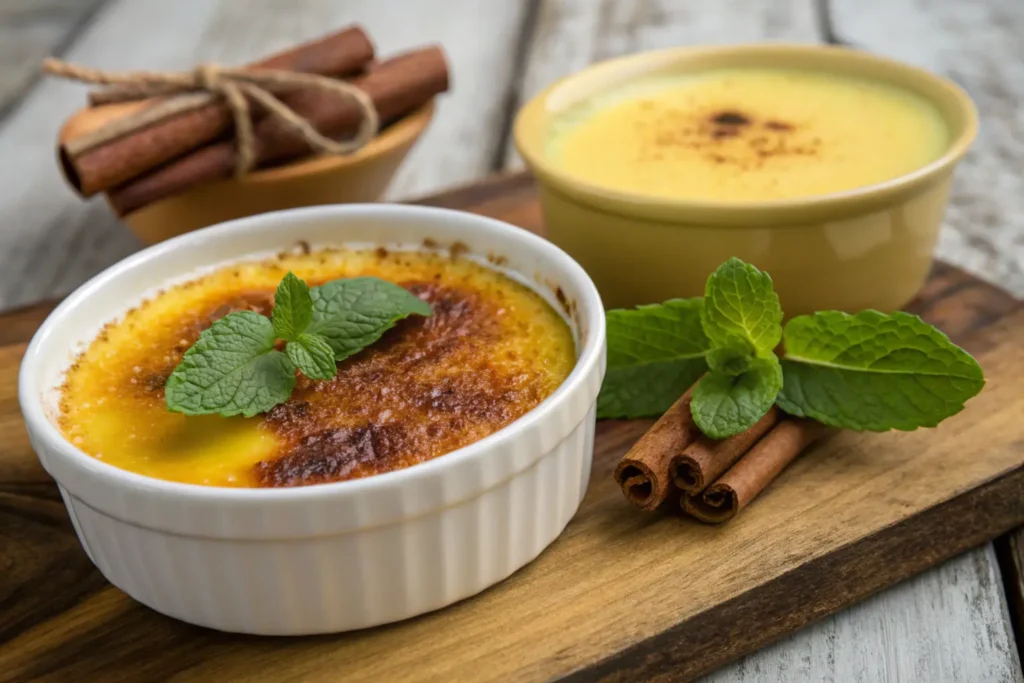


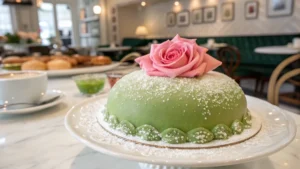
1 thought on “What’s the Difference Between Crème Brûlée and Custard?”